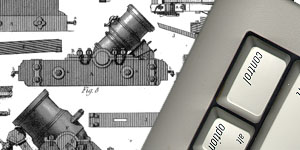


The Whites of Their Eyes
Just before dawn on Tuesday, April 15, 1986, eighteen American fighter-bombers were en route to Libya. Flying low to avoid radar detection, they were tasked with destroying some barracks, a seaport, and an airport as reprisals for terrorist attacks. But because the targets were located in and around the heavily populated city of Tripoli---and because America and Libya weren't actually at war---the bombers couldn't simply carpet bomb everything and leave.During the Second World War, there were no electronic computers. There was nothing small enough and smart enough to fit in a bomb and do anything useful. So fifty years ago, all effective bombing was carpet bombing, because all bombs were dumb bombs. After release, they simply fell.
During the raid on Libya, however, each bomb had its own computer and movable fins. When a bomber pointed a laser beam at a target and released its bombs, each bomb's computer homed in on the illuminated spot by adjusting its guidance fins. The bombers were moving so fast, however, that pilots only had about twenty seconds to find, pinpoint, and illuminate their targets. During that twenty seconds they could also be under heavy antiaircraft fire. So, the bombers were supposed to sneak in low and fast to avoid radar detection. Then---in twenty seconds, more or less---they had to pinpoint the targets using heat-detecting cameras, illuminate them with their lasers, release the bombs, keep the lasers aimed until the bombs hit, then skedaddle for home.
That isn't quite what happened. America chose not to use its then-secret stealth fighters and instead sent radar-detectable warplanes on the mission. The Libyan military picked them up on radar and attacked with missiles and gunfire. As the pilots tried to evade the fire, some of the laser beams drifted far off their targets, and the bombs blew up whatever the lasers illuminated last---in one case, part of the French embassy in Tripoli.
War is never like the simulations of it before the battle, nor like the sanitized versions shown on television. Opponents have a stake in winning too, and try hard to win. There would be no war if that weren't so. Computers or no, war will always be a high stakes contest of attack and counterattack, feint and counterfeint.
Between the 1986 airstrike on Libya and the 1991 Gulf War computers grew ever cheaper, faster, and smaller, and smart bombs became more independent. Now bombers need only illuminate their targets for a few seconds to let the bombs pick up the video images, analyze them, and home in on their own. Other, even more precise bombs carry a rocket in their tail and a video camera in their nose so that pilots can guide them from far away. Smart bombs are now smart missiles, and the time to aim and fire them effectively has dropped from twenty seconds to five seconds.
Thanks to computers, weapons are becoming smarter and more independent. Once upon a time, our weapons were so slow and inaccurate that we had to wait until we could see the whites of their eyes. Now we don't even have to wait until we can see their country, let alone their eyes.